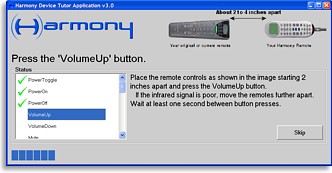|
...Continued from Page 5.
After connecting to HarmonyRemote.com, the initial step is creating a new user account. Only one remote can be associated to an account, however if you’re upgrading from a SST-745 to the SST-768 the site will automatically convert your setup. If you have multiple Harmony remotes, separate accounts are needed. It would be nice if the monitoring program could also automatically log you into HarmonyRemote.com... does a remote control really warrant manually typing in a password every time?
The next step is downloading a simple program that double-checks the Harmony’s connection to your computer and updates the firmware if needed. My remote shipped with v1.5, but v1.6 was available. Although the dialogue box warns that the upgrade process may take several minutes, it was completed in about 30 seconds. Immediately after the upgrade the remote will no longer be usable – a message appears and asks you to connect to the internet. This is because the upgrade removes the default setup, which was superfluous anyway, only offering a way to test the remote out of the box.

Choosing your devices.
|
Programming-by-numbers.
Once the remote is up-to-date, the actual programming process begins on the website. Much like a paint-by-numbers picture, everything at this point is displayed logically and arranged in order. The site warns you not to use the browser’s “back” button, as that can mess everything up, but generally offered no other way to go back and correct a previous mistake or cancel the current operation, besides starting off back at the home page.
The first task is selecting which devices you have in your system, by ticking off items on a long list. Available device categories include amplifiers, cable boxes, CD players, DAT decks, digital cable boxes, DVD players, DVRs, lighting systems, LD players, MD players, mini systems, projectors, receivers, satellite receivers, tape decks, televisions, VCRs... and those are just some of them. Only one of a particular component type can be selected at this time, so if you have two of something the second will have to be configured later.

Learning codes.
|
The Harmony is both a full learning remote control and a semi-preprogrammed remote. Although it doesn’t include an infrared code database in the traditional sense, it has access to Intrigue’s database of devices configured by other Harmony owners. The benefit of this system is that, theoretically, devices in the Intrigue database matching the model number of a new owner’s device will already be set up with the right behaviors and should work perfectly. The downside is that Intrigue is relying on users – not always an infallible source – to correctly enter everything related to their components. Additionally, the database may take a while to become as diverse as some of the big commercial ones available for license, although at the time of this writing Intrigue is reporting over 10,000 preconfigured devices.
Almost preprogrammed...
The next screen prompts you to enter in the exact model numbers of your components. These are compared to the pre-existing list of components configured by other Harmony owners. If something you own has already been entered into the database, the Harmony already has enough information to know, basically, how the device works. If the model numbers don’t match, as was the case with two of my system devices, the site attempts to determine the exact type of device by decoding its infrared protocol. It downloads another little program to the computer which asks you to learn a command – any command – from the unknown device’s remote through the Harmony. That code is then uploaded over the Internet and analyzed by Intrigue’s special algorithms.
| 
